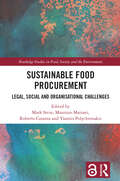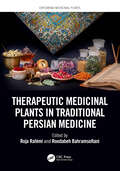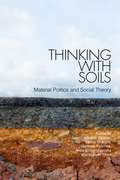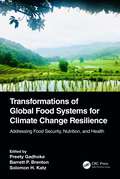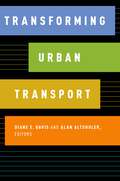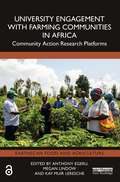- Table View
- List View
Sustainable Food Procurement: Legal, Social and Organisational Challenges (Routledge Studies in Food, Society and the Environment)
The book examines sustainable food procurement policy and practice in the European Union and beyond, exploring the extent to which sustainability objectives have been achieved and evaluating the new developments taking place at both EU and national levels.While there is a growing recognition that public authorities can use public procurement as a policy tool to pursue multiple environmental, health and socio-economic objectives, contracting authorities still face many challenges. This volume investigates the scope for pursuing sustainable objectives in public procurement of food and catering services, examining different regulatory contexts and organisational models to answer the overall question of how to integrate sustainability concerns into the various phases of public food procurement processes. Contributions in the book examine the policy and legal procurement framework and practices for sustainable public catering in three EU Member States: Italy, France and Spain. There is a comparative survey of the Baltic Region, including Denmark, Estonia, Finland, Poland and Russia, and moving beyond the EU, there is examination of the UK and Brazil, as well as a cross country comparison of the UK with Denmark and Sweden. Drawing on the expertise of an interdisciplinary and intersectoral team of contributors allows the book to benefit from the insights of different disciplines, including business sciences, anthropology and law. Tapping into the global discussion on public food procurement as a means to achieve multiple social and environmental goals, this work will stimulate readers looking for new creative ways to create value through public food purchasing.This book will be of great interest to students, researchers, policymakers and public- and private-sector representatives interested in public procurement, food policy and law, sustainable food sourcing and supply chain management.
Sweets (Large Print)
There is an image of three sweets on this page: a lollipop and two more sweets wrapped in coloured paper. There is a locator dot shown, which will be at the top left of the page when the image is the correct way up. The yellow lollipop is on the left side of the page, near the top. It has the round sweet bit at the top with a red spiral decoration on it, and down from this is its long stick. There is another sweet to the right of the lollipop. It has its violet paper wrapping twisted up to the left and right. In the bottom centre of the page is the third sweet. It is round, and like the one up the page it has its red and pink paper wrapping twisted up to either side.
Therapeutic Medicinal Plants in Traditional Persian Medicine (Exploring Medicinal Plants)
Traditional Persian Medicine (TPM) is one of the oldest medical doctrines, globally known due to pioneering physicians and scientists. The greatest source of natural medicines in TPM originates from medicinal plants. Therapeutic Medicinal Plants in Traditional Persian Medicine provides a background on the history of TPM, as well as an introduction to 40 of the most popular medicinal plants used in TPM. It is a practical guide for readers interested in medicinal plants used in the prevention, management, and treatment of different diseases.Features: Includes both traditional therapeutic applications and modern evidence/ uses Makes a comparison between preclinical and clinical studies Provides information on major chemical constituents, therapeutic uses, adverse reactions, and safety for each plant species A volume in the “Exploring Medicinal Plants” series, this book is a valuable resource for researchers, students, academicians, and scientists dealing witth medicinal plants, as well as for those interested in the fields of pharmacognosy, naturopathy, phytotherapy, and traditional medicines.
Thinking with Soils: Material Politics and Social Theory
This book presents a novel and systematic social theory of soil, and is representative of the rising interest in 'the material' in social sciences. Bringing together new modes of 'critical description' with speculative practices and methods of inquiry, it contributes to the exploration of current transformations in socioecologies, as well as in political and artistic practices, in order to address global ecological change.The chapters in this edited volume challenge scholars to attend more carefully to the ways in which they think about soil, both materially and theoretically. Contributors address a range of topics, including new ways of thinking about the politics of caring for soils; the ecological and symbiotic relations between soils; how the productive capacities and contested governance of soils are deployed as matters of political concern; and indigenous ways of knowing and being with soil.
Tomato (Cross Section) (Large Print)
This is a labelled image of a tomato shown in longitudinal cross section (cut through from top to bottom). There is a locator dot shown, which will be at the top left of the page when the image is the correct way up. The image of the tomato is in the middle of the page.v At its centre is the fruis core and this is surrounded by seeds in the locular cavities. They have a gelatinous covering and are attached to the core by jelly-like threads. On the outside of the fruit are its flesh and skin. At the top of the image is the stem of the tomato with a leaf to the left and right. Tomatoes vary in size between the cherry tomato at about two centimetres to monsters of twelve centimetres, weighing up to three kilos. Although usually a bright red, tomatoes range in colour from a deep red through orange to pale yellow.
Tomato (Cross Section) (UEB Contracted)
This is a labelled image of a tomato shown in longitudinal cross section (cut through from top to bottom). There is a locator dot shown, which will be at the top left of the page when the image is the correct way up. The image of the tomato is in the middle of the page.v At its centre is the fruis core and this is surrounded by seeds in the locular cavities. They have a gelatinous covering and are attached to the core by jelly-like threads. On the outside of the fruit are its flesh and skin. At the top of the image is the stem of the tomato with a leaf to the left and right. Tomatoes vary in size between the cherry tomato at about two centimetres to monsters of twelve centimetres, weighing up to three kilos. Although usually a bright red, tomatoes range in colour from a deep red through orange to pale yellow.
Tomato (Cross Section) (UEB Uncontracted)
This is a labelled image of a tomato shown in longitudinal cross section (cut through from top to bottom). There is a locator dot shown, which will be at the top left of the page when the image is the correct way up. The image of the tomato is in the middle of the page.v At its centre is the fruis core and this is surrounded by seeds in the locular cavities. They have a gelatinous covering and are attached to the core by jelly-like threads. On the outside of the fruit are its flesh and skin. At the top of the image is the stem of the tomato with a leaf to the left and right. Tomatoes vary in size between the cherry tomato at about two centimetres to monsters of twelve centimetres, weighing up to three kilos. Although usually a bright red, tomatoes range in colour from a deep red through orange to pale yellow.
Transformations of Global Food Systems for Climate Change Resilience: Addressing Food Security, Nutrition, and Health
Transformations of Global Food Systems for Climate Change Resilience: Addressing Food Security, Nutrition, and Health provides poignant case studies of climate change resilience frameworks for nutrition-focused transformations of agriculture and food systems, food security, food sovereignty, and population health of underserved and marginalized communities from across the globe. Each chapter is drawn from diverse cultural contexts and geographic areas, addressing local challenges of ongoing food and health system transformations and illustrating forms of resistance, resilience, and adaptations of food systems to climate change. Fourteen chapters present global case studies, which directly address the United Nations Sustainable Development Goals and the Food and Agriculture Organization’s global call to action for transforming agriculture, addressing food security and nutrition, and the health of populations impacted by climate change and public health issues.They also integrate reflections, insights, and experiences resulting from the COVID-19 Pandemic. This edited volume includes research on (1) enhancing food sovereignty and food security for underserved populations with a particular focus on indigenous peoples; (2) improving locally contextualized definitions and measurements of climate change resilience, food security, hunger, nutrition, and health; (3) informing public health programs and policies for population health and nutrition; and (4) facilitating public and policy discourse on sustainable futures for community health and nutrition in the face of climate change and natural disasters, including ongoing and future pandemics or emergencies. Within this book, readers discover an array of approaches by the authors that exemplify the mutually engaged and reciprocal partnerships that are community-driven and support the positive transformation of the people with whom they work. By doing so, this book informs and drives a global sustainable future of scholarship and policy that is tied to the intersectionality and synergisms of climate change resilience, food security, food sovereignty, nutrition, and community health.
Transforming Urban Transport
Transforming Urban Transport brings into focus the origins and implementation pathways of significant urban transport innovations that have recently been adopted in major, democratically governed world cities that are seeking to advance sustainability aims. It documents how proponents of new transportation initiatives confronted a range of administrative, environmental, fiscal, and political obstacles by using a range of leadership skills, technical resources, and negotiation capacities to move a good idea from the drawing board to implementation. The book's eight case studies focus on cities of great interest across the globe--Los Angeles, Mexico City, New York, Paris, San Francisco, Seoul, Stockholm, and Vienna--many of which are known for significant mayor leadership and efforts to rescale power from the nation to the city. The cases highlight innovations likely to be of interest to transport policy makers from all corners, such as strengthening public transportation services, vehicle and traffic management measures, repurposing roads and other urban spaces away from their initial function as vehicle travel corridors, and turning sidewalks and city streets into more pedestrian-friendly places for walking, cycling, and leisure. Aside from their transformative impacts in transportation terms, many of the policy innovations examined here have altered planning institutions, public-private sector relations, civil society commitments, and governance mandates in the course of implementation. In bringing these cases to the fore, Transforming Urban Transport advances understanding of the conditions under which policy interventions can expand institutional capacities and governance mandates, particularly linked to urban sustainability. As such, it is an essential contribution to larger debates about what it takes to make cities more environmentally sustainable and the types of strategies and tactics that best advance progress on these fronts in both the short- and the long-term.
University Engagement with Farming Communities in Africa: Community Action Research Platforms (Earthscan Food and Agriculture)
This book explains and explores how collaborations can be built and strengthened between African universities and farming communities to address real-world contemporary challenges. The book focuses on Community Action Research Platforms, an approach that has successfully enabled African universities to break free of the ivory tower and prove their relevance to society through deep collaborative engagements in targeted agricultural value chains. Developed in a pan-African network of universities (RUFORUM) focused on capacity building in agriculture, the approach has been tested in diverse settings over the last 15 years. The book draws on the experiences and lessons from 21 different projects initiated by RUFORUM member universities in Benin, Botswana, Ethiopia, Ghana, Kenya, Malawi, Namibia, South Africa, Sudan, Tanzania, Uganda and Zimbabwe. It highlights a critical yet underutilised role for African universities as collaborators and catalysts for multisector solutions. These are solutions that increase productivity and address climate change. They develop livelihoods and resilience in rural communities, as well as promote farmers’ access to markets, innovation and trade while safeguarding biodiversity and enhancing food and nutrition security. The book makes a case for repositioning African universities as fulcrums of development in society. It shares the rich experiences, learnings and scientific findings of diverse researchers, practitioners and students who have been working towards achieving this reality on the ground. This multidisciplinary book holds appeal for university leaders, higher education, agrifood and development specialists, researchers and practitioners, policymakers and development agencies engaged in African agriculture and rural development, higher education and sustainable growth.
